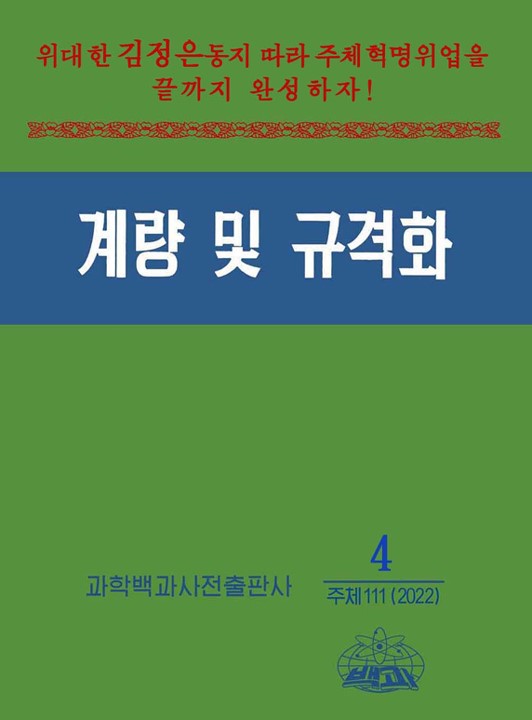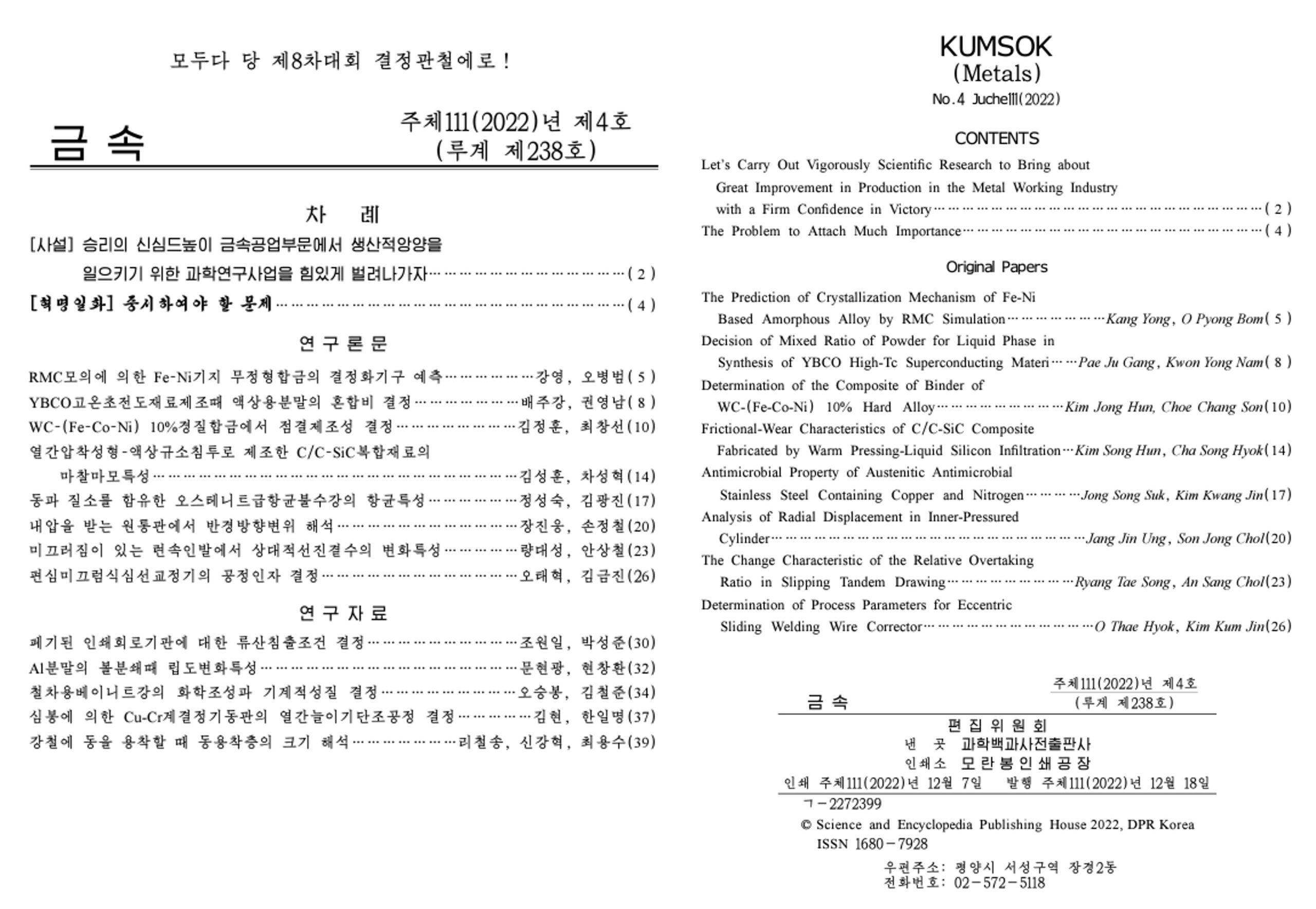Measurement and Standardization (계량 및 규격화 / Kyeryang mit Kyugyokhwa)
Measurement and Standardization
계량 및 규격화 / Kyeryang mit Kyugyokhwa
Translation and backgrounder by Stephen Mercado
A quarterly journal covering issues and techniques in scientific and industrial measurement and standardization, published by the Science and Encyclopedia Publishing House.

Journal Title: The journal title has various renderings. Measurement and Standardization is the title in English. Its name transliterated in a simplified version of the standard McCune-Reischauer (M-R) transliteration system and the actual title in Korean are listed above. Its full M-R transliteration, as used in catalogs of the Library of Congress and other major libraries, is Kyeryang mit kyugyŏkhwa. In the English version of the journal’s table of contents, the transliteration, rendered in all caps, is KYERYANG MIT KYUKYOKHWA. Below it appears between parentheses an English version: (Measuring Science and Standardization). “Measuring Science” is not the standard translation for kyerang / 계량, which is better translated as “measurement.” In North Korean media, the journal title is transliterated as Kyeryang mit Gyugyokhwa.
Author Information: Editorials and anecdotes of the Revolution (혁명 일화) are unsigned. The research papers show author names but lack other information common to science papers, such as academic or professional affiliation, academic titles, areas of research or author biography. The journal’s title suggests that authors may be affiliated with relevant institutes of the State Academy of Sciences and/or related university departments.
Subject Matter: The articles touch on a variety of issues and techniques in measurement and standardization—such as achieving high accuracy in measuring the linear expansion coefficient of metal—in various industries.
References: In general, an article in the section “Research Papers” and “Research Data” has two or three endnotes. Domestic citations include journal articles and monographs related to measurement and standardization. Examples of relevant domestic citations include the book 측정오차와 측정불확정도 [Measurement Error and Measurement Uncertainty], Pyongyang: Industrial Publishing House, 2015. Examples of foreign citations include a 2015 book from Peking University Press, 现代气象观测 [Modern Meteorological Observation] and a 2002 article by V. Didenko et al., “Polynomial and piece-wise linear approximation of smart transducer errors,” in the journal Measurement: Journal of the International Measurement Confederation. Articles in the section “Standardization and Quality Management” lack the endnotes found in the sections “Research Papers” and “Research Data.”
Sections: Each issue comprises a front cover; an unnumbered page with a framed quotation of one of the three generations of the Kim family; a table of contents (TOC) in Korean; the articles; a TOC in English; the publishing information; and the back cover. Regime messages/propaganda appear throughout the journal.
In recent years, the front cover shows a lead quotation over the journal title, under which is the name of the publisher, the issue number and year of issue and the corporate logo. The TOC in Korean starts with two or three items, each either an editorial or an anecdote of the Revolution. There follows some number of articles under the sections “Research Papers” (연구론문) and “Research Data” (연구자료). Some issues include other sections. Issue 3, 2022, for example, includes after the main two sections, a large one with the title “Standardization and Quality Management” (규격과와 품질과리) and a final “Legal Commentary” (범무해설) section, consisting in this issue of a single article. Issues from early in the previous decade, such as Issue 1, 2011, show two main sections: “Measurement Science” (계량과학) and “Standardization and Quality Management.” Following the articles is an abbreviated TOC in English; there are no translations in recent issues for the material following the section “Research Papers,” which is translated as “Original Papers.” In Issue 1, 2011, there is no translated TOC after the first four of the eight articles in the “Measurement Science” section, translated as “Original Papers.” Next, there is the publishing information. The back cover, for its part, has included in recent years at the lower right corner the journal’s International Standard Serial Number (ISSN) over a bar code.

Publisher: The publisher’s name, in English, is the Science and Encyclopedia Publishing House. It is the Kwahak Paekkwa Sajon Chulpansa in simplified M-R and 과학백과사전출판사 in Korean. The publisher’s name appears in Korean on the journal’s cover and in English on the copyright line on the publishing information page. In addition, the front cover includes the publisher’s logo: a globe, with a representation of the atom imposed at the top and an abbreviated version of the publisher’s Korean name, 백과 (Paekkwa), at the bottom.
Prior to Issue 3, 2018, the publisher’s name printed on the front cover was 과학기술출판사 (Kwahak Gisul Chulpansa, the Science and Technology Publishing House). Confusingly, the front cover for the 2016 and 2017 issues, as well as the first two issues of 2018, show the Science and Technology Publishing House name together with the Paekkwa corporate logo.
The publisher publishes an issue each quarter, starting in January, for a total of four issues per year. According to the TOC and publishing information page, Issue 3 (July), 2022 was cumulative issue number 197. The publishing information page also indicated that there was an editorial committee (no members named), the publisher was the Science and Encyclopedia Publishing House, the place of printing was the Moranbong Printing Plant, the date of printing was 6 July Juche 111 (2022), and the date of issue was 21 July Juche 111 (2022). The copyright line was © Science and Encyclopedia Publishing House 2022, DPR Korea. The publishing information has shown changes over time; for example, in the first issue of 2011, the place of printing was the Pyongyang General Printing Plant, and the journal showed no copyright line or telephone number. The information page copyright line consisted only of the copyright symbol ©, followed on the same line by the ISSN.
